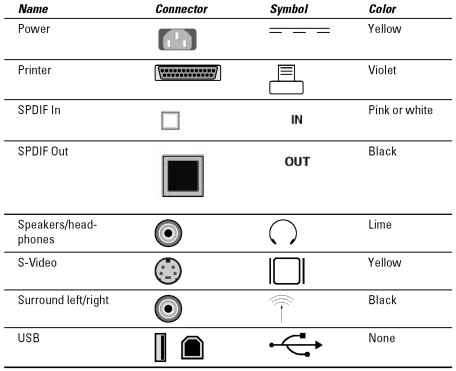In This Chapter
Recognizing different types of PCs Looking at the basic PC hardware Perusing items on the console Locating PC connectors, holes, and jacks Using helpful symbols and colors
The very first PCs were not known for their stunning, aerodynamic designs. They were hefty metal boxes — intimidating, beige. By contrast, today’s PCs have a sleek, almost aerodynamic, design to them. They can come in a wide array of bold colors. Some newer models sport ominous internal lighting, an evil glowing red or a cool blue, hinting at some internal, hideous intelligence.
Well, forget anything about computer hardware being intelligent. In a computer system, the hardware plays a subservient role to software, which is the real brain. Still, it’s important to know about basic computer hardware. This chapter provides a quick overview, showing things you’ll find on a PC that can be interesting and useful.
Even though your PC may sport an aerodynamic design, that doesn’t imply flightworthiness — despite any desire you may have to hurl the computer out a window.
The Mundane PC
Figure 2-1 shows a typical personal computer system. Try to avoid the urge to yawn.
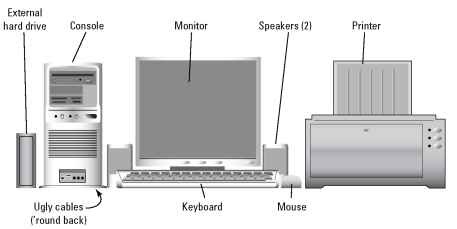
Figure 2-1:
Basic computer things.
The big, important pieces have been labeled in Figure 2-1 for your enjoyment. You should know which piece is which and what the proper terms are:
Console: The main computer box is the console, although it may also be called the system unit (geeky) or the CPU (incorrect). The box contains your computer’s soul, its electronic guts. Adorning the outside of the console are various buttons, lights, and holes into which you plug the rest of the computer system.
Monitor: The monitor is the device where the computer displays information — its output. A common mistake made by new computer users is to assume that the monitor is the computer. Nope. The console is the computer. The monitor merely displays stuff.
Keyboard: It’s the thing you type on; it’s the primary way you communicate with the computer, with input.
Mouse: No rodent or pest, the computer mouse is a helpful device that lets you work with graphical objects displayed on the monitor.
Speakers: PCs bleep and squawk through a set of stereo speakers, which can be external jobbies you set up (refer to Figure 2-1), speakers built into the console or monitor, or perhaps even headphones. Pay more money and you can even get a subwoofer to sit under your desk. Now, that will rattle the neighborhood’s windows.
External hard drive: You may or may not have one (yet), but an external hard drive is used to back up, or create a safety copy, of the important stuff you store on your computer.
Printer: It’s where you get the computer’s printed output, also called hard copy.
You may find, in addition to these basic items, other items clustered around your computer, such as a scanner, a digital camera, a gamepad or joystick, a high-speed modem, or many, many other toys — er, vital computer components.
One thing definitely not shown earlier, in Figure 2-1 — and something you will never see in a computer manual and especially not in advertisements — is the ganglion of cable that lives behind each and every computer. What a mess! These cables are required in order to plug things into the wall and into each other. No shampoo or conditioner on Earth can clean up those tangles.
Ensure that you know where the console, keyboard, mouse, speakers, monitor, and printer are in your own system. If the printer isn’t present, it’s probably a network printer sitting in some other room.
Chapters in Part II of this topic go into more detail on the individual computer components just introduced and illustrated in Figure 2-1.
CPU stands for central processing unit. It’s another term for the computer’s processor (see Chapter 6). Even so, some folks foolishly refer to the console as the CPU. Boy, are they wrong!
The Console Tour
Of all the computer hardware that makes up a computer system, the console is the most important (refer to Figure 2-1). But what exactly is a console?
Thanks to major conspiracies and a generally evil sense of humor in the computer industry, not all consoles look the same. Not only that, vital locations are found on the console, useful places that each manufacturer deliberately puts in a different spot. You need to know where those things are if you want to add them and use them. The following sections help.
There is no typical console
All PC consoles feature the same basic hardware, doodads, and goobers spotting the case like warts on a witch. But, just as there’s no typical car, there’s no typical computer console. You can’t say, “If you’ve seen one, you’ve seen ‘em all!” That’s because one PC can look as different from another as a sports car looks different from a pickup truck.
Figure 2-2 illustrates six common PC configurations, and the following list describes them.
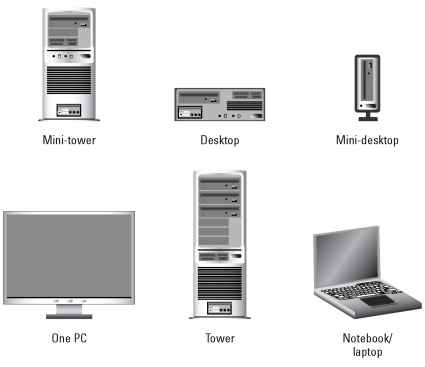
Figure 2-2:
PC configurations, various and sundry.
Mini-tower: The mini-tower is the most popular console type. It can sit on top of a desk, right next to the monitor (refer to Figure 2-1). It can also be tucked away out of sight, below the desk.
Desktop: Once the most popular type of console, the desktop PC sits flat on the desk. The monitor usually squats on top of the console in the standard desktop configuration.
Mini-desktop: The mini-desktop console is just too cute and tiny, about the size of a college dictionary. That makes it ideal for places where space is tight, and where budgets are tight. The downside is that these consoles lack internal expansion options.
One PC: A popular and trendy computer design combines the console and monitor into a single unit. From the front, the console looks like a monitor, though it’s thicker. On the sides, you find the optical drive plus the myriad of connectors and other computer doodads.
Tower: The tower console is essentially a taller version of the mini-tower. The bonus with the tower is internal expansion options, making this type of console ideal for power-mad users. A tower typically sits on the floor, often propping up one end of the table.
Notebook/laptop: A specialty type of computer that folds into a handy, lightweight package, ideal for slowing down the security checkpoints in airports. Laptop PCs work just like their desktop brethren; any exceptions are noted throughout this topic.
Choosing the proper PC configuration depends on your needs. Power users love the expandability of the tower. Those on a budget may go for a mini-desktop. Folks on the go love laptops.
No matter how big your computer, the amount of clutter you have always expands to fill the available desk space.
Though you can find separate mini-tower and desktop configurations, many of the mini-tower PCs are often sold as “desktop” models.
Another type of laptop is the tablet, which lets you enter information by writing on the screen using a special tool called a stylus.
For the highly mobile Internet crowd, a special teensy-laptop category is the netbook. Lilliputians love ‘em.
More laptop (and tablet) information is in my topic Laptops For topic available at fine stores all over planet Earth.
The amount of space a PC console occupies is often referred to as its footprint. Smaller consoles are small footprint PCs.
Major points of interest on the console, front
After many years, PC manufacturers discovered that it works best to put those items designed for you, the human, on the front part of the console. I’m not joking: Early PCs had nearly everything on the console’s back side. So consider yourself blessed and use Figure 2-3 as your reference as you go hunting for the following items:
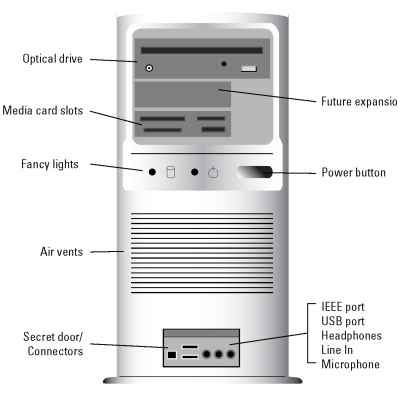
Figure 2-3:
Items to note on the front of the console.
Optical drive: The computer’s primary removable storage media is the optical disc. The optical drive reads optical discs, computer CDs, or DVDs, just like music CDs or movie DVDs. Read more about this topic in Chapter 9.
Future expansion: Most consoles feature blank spots. They may look interesting or useful, but they’re not! They’re simply blanks that cover holes used for adding new features to your PC.
Media card slots: These slots are used for reading common media cards, such as those used by digital cameras or portable electronic gizmos. See Chapter 9 for more information about media cards.
Air vents: Air vents aren’t impressive, but they’re necessary. They keep the console cool by helping air circulate inside. Don’t block the air vents with topics or sticky notes!
The secret panel: Whether it’s covered by a door or not, your PC most likely features a clutch of various connectors somewhere on its front. Nestled in that area, you find places to connect joysticks, microphones, headphones, digital video, or other handy gizmos you may need to plug and unplug from time to time.
Buttons and lights: Most computer buttons are on the keyboard. A few of the more important buttons are on the console, and on fancier PCs are accompanied by many impressive, tiny lights. These buttons and lights include
Power button: No longer a plain on-off button, the power button can do more than just turn the computer off or on. See Chapter 4 for the details.
Reset button: Rare but still found on some consoles is a button that forces the computer into a restart during times of woe. Consider it a plus if your PC features this button.
Hard drive light: This wee light flashes when the PC’s primary storage media, the hard drive, is being accessed. A light that’s sometimes on the optical drive does the same thing.
You might be lucky and find other fun and unusual items living on the front of your PC’s console. They’re probably particular to a certain computer brand or model. Consider them a bonus.
The front of the console may also boast a brand label or manufacturer’s tattoo.
Some newer computers have stickers that show the secret Windows installation number or proclaim such nonsense as “I was built to run Windows Optimus Prime” or “A Pentium hoohah lurks inside this box.”
For more specific information on the connectors lurking behind a secret panel, see the section “The I/O panel,” later in this chapter.
Don’t block the air vents on the front of the console. If you do, the computer may literally suffocate. (It gets too hot.)
A hard drive light can be red or green or yellow, and it flickers when the hard drive is in use. Don’t let it freak you out! It’s not an alarm; the hard drive is just doing its job.
Stuff found on the console’s backside
The console’s backside is its busy side. That’s where you find various connectors for the many devices in your computer system: a place to plug in the monitor, keyboard, mouse, speakers, and just about anything else that came in the box with the PC, or which you might add later.
Use Figure 2-4 as a guide for finding important items on the back of your PC’s console. Note that some things may look different and some may be missing; not every console is the same.
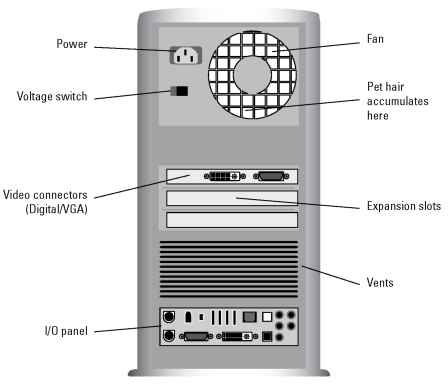
Figure 2-4:
Important doodads on the back of the console.
Power: The console needs power, and the power connector is where you plug in the power cord. The other end plugs into the wall.
Fan: Air gets sucked in here. Or it might be blown out. I forget which.
Voltage switch: Use this switch to change power frequencies to match the specifications for your country, region, or planet.
Expansion slots: These slots are available for adding new components on expansion cards to the console and expanding your PC’s hardware. Any connectors on the expansion cards appear in this area, such as the video connectors on a graphics adapter (refer to Figure 2-4).
Vents: The breathing thing again.
I/O panel: Aside from the power cord, and anything attached to an expansion card, the rest of your PC’s expansion options and plug-in-type things are located in a central area that I call the I/O panel. Details of what you can find there are covered in the next section.
The I/O panel
To either help keep all connectors in one spot or just create the most intensely cable-crammed location on the console, your PC’s console features an I/O panel on its rear. That location is where you add various expansion options to the PC as well as plug in the standard devices shown way over in Figure 2-1.
Use Figure 2-5 as your guide for what’s what. The items you find on your PC’s I/O panel may be labeled with text, or they may include the symbols listed later, in Table 2-1. Also keep in mind that Figure 2-5 is only a guide; your PC console may have a different layout and sport more or fewer items on the I/O panel.

Figure 2-5:
Stuff to find on the I/O panel.
Center/subwoofer: For a surround sound audio system, you plug the center speaker or subwoofer, or both, into this jack.
Headphones/speakers: Into this hole you plug in your PC’s external speakers or headphones, or it’s where you hook up the PC to a sound system. (Also check the “secret panel” on the front of the console for a headphone connector.)
IEEE 1394 (FireWire): This type of versatile connector is similar to USB. See Chapter 7.
Keyboard: The keyboard plugs into this little hole.
Line In: You use this jack to plug a traditional audio-producing device (stereo, phonograph, or VCR, for example) into the PC for capturing sound.
Microphone: The computer’s microphone plugs into this jack. A similar jack might also appear on the front side of the console.
Mini 1394: This special version of the IEEE 1394 connector is designed specifically for digital video.
Mouse: This hole is generally the same size and shape as the keyboard connector, although a mouse icon nearby lets you know that the mouse plugs in here.
Network: Plug in a local-area network (LAN) connector or attach a broadband modem to the PC.
SPDIF In, SPDIF Out: These connectors are used for digital audio. Special fiber optic cable is required: Audio coming into the computer plugs into the In hole; the sound the computer generates goes out the Out hole.
Surround left/right: Also for surround sound, this jack is the one in which you plug the rear left and right speakers.
USB: Plug snazzy devices into these Certs-size Universal Serial Bus (USB) slots. See Chapter 7 for more information about USB.
Video: Your PC’s monitor can plug into one of the video adapters on the I/O panel, either the traditional VGA adapter or, if you have a digital monitor, the Digital video adapter. Newer PCs may even sport an HDMI adapter for super-duper digital video. See Chapter 10 for more information on computer video.
The good news? You connect all this stuff only once. Then your PC’s butt faces the wall for the rest of its life and you never have to look at it again (well, unless you add something in the future or you just enjoy looking at PC butts).
The keyboard and mouse connectors are different! Be certain that you plug the proper device into the proper hole, or else the keyboard and mouse don’t work!
See Chapter 7 for more information on these holes and what plugs into them.
The I/O panel might also feature a jack for connecting a dial-up modem, though such jacks are more common on laptop computers than on desktop models.
Older PCs may sport ports not shown in Figure 2-5. These ports include the serial or COM port, the printer port, and the joystick port. The functions of these ports have been replaced with USB ports, which are plentiful on modern PCs.
Helpful hints, hieroglyphics, and hues
Even though most PC connectors are different, manufacturers have relented and agreed upon a set of common colors and symbols used to label the various holes, connectors, and ports on the console’s rump. They’re listed in Table 2-1 to help you find things, in case the need arises.

